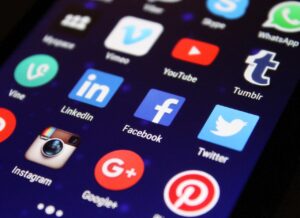Are you ready to up your sales game by creating and using catchy selling phrases to grow sales and grab your customers’ attention?
But wait, what’s a catchy selling phrase? For our purposes, it’s a brief, memorable, and persuasive statement that’s strategically designed to capture the attention of potential customers and convey the distinct value proposition or advantages of a product or service in a way that deeply resonates with them.
We’re talking about phrasing used in email headlines, content for social media posts, slogans or taglines for ads, or compelling micro scripts that can be used in conversations with potential customers.
Why are these phrases so important?
In today’s fast-paced and highly competitive business world, it’s crucial to communicate powerful and persuasive messages that resonate with your audience. A well-crafted phrase can grab the attention of potential customers, pique their interest, and even make them excited to learn more about what you have to offer. In a world where attention spans are short and consumers are bombarded with countless messages every day, a great selling phrase can help you stand out from the crowd and make a lasting impression. It’s a simple but effective way to communicate your unique value proposition and make an emotional connection with your target audience. So, if you want to capture the hearts and minds of your customers, incorporating catchy selling phrases into your marketing strategy is a must!
So, let’s dive in and discover the secrets to crafting memorable selling phrases that will boost your sales and grow your business of any size, in any industry, and for both product-based and service-based companies.
These are the questions we’ll attempt to answer today:
Can you show me some examples of the different types of selling phrases?
How can I create amazing phrases on my own?
What can I do when I need some “Wow!” phrases to be a powerful part of my business message?
What are some Key Do’s and Don’ts in creating Selling Phrases?
What are the different types of selling phrases?
There are three main categories of using catchy selling phrases to grow sales we’re considering here: slogans, taglines, and micro scripts. Each has its unique purpose and format, but they all aim to persuade potential customers to buy your product or service, or buy more of it.
Slogans
A slogan is a short and memorable phrase that encapsulates your brand’s mission, values, and unique selling proposition. Slogans are often used in advertising campaigns, on packaging, and in marketing materials. A good slogan should be catchy, memorable, and succinct. Some of the most famous slogans of all time include:
- “Just Do It” by Nike
- “I’m Lovin’ It” by McDonald’s
- “The Ultimate Driving Machine” by BMW
- “Got Milk?” by the California Milk Processor Board
- “Think Different” by Apple
Taglines
A tagline is a short phrase that is used to represent a company or product. Unlike a slogan, which is used in advertising campaigns, taglines are used consistently across all marketing channels to create brand recognition and identity. A good tagline should be concise, and memorable, and communicate your brand’s unique value proposition. Some of the most famous taglines of all time include:
- “Because You’re Worth It” by L’Oreal
- “Melts in Your Mouth, Not in Your Hands” by M&M’s
- “The Quicker Picker Upper” by Bounty
- “The Happiest Place on Earth” by Disneyland
- “Finger-Lickin’ Good” by KFC
Micro Scripts
A micro script is a short and simple phrase that is used to communicate your brand’s message or value proposition. Unlike a slogan or tagline, which are often used in advertising, micro scripts can be used in various contexts, including sales pitches, social media posts, and customer interactions. A good micro script should be easy to remember and communicate your brand’s unique value proposition. Some examples of effective micro scripts include:
- “Our technology, your competitive advantage.”
- “Leading the way in innovation and service.”
- “Modernizing the way you work and grow.”
- “Seamlessly integrate with your existing systems.”
- “Our team is your strategic partner.”
How to create catchy selling phrases to grow sales

To start with, we’ll cover a five-step process for writing effective selling phrases
Identify your target audience and their pain points or desires. Understanding your audience is critical in crafting selling phrases that will resonate with them.
Highlight the key benefits of your product or service. Focus on how your offering can solve a problem or improve someone’s life.
Use emotional triggers to appeal to your audience’s aspirations and desires. People are more likely to take action if they feel a strong emotional connection to your message.
Keep it concise, clear, and easy to understand. A great selling phrase should be memorable and repeatable, so avoid using jargon or overly complicated language.
Test your phrases to see which ones resonate most with your audience. Try out different variations and see which ones get the most engagement or drive the most conversions. Use this feedback to refine and improve your selling phrases over time
With this framework in mind, let’s explore 20 additional suggestions and examples to help you create outstanding Slogans, Taglines, or Micro Scripts.
Know your audience: The first step in creating an effective selling phrase is to know your audience. Who are you selling to? What are their needs and desires? What language do they use? By understanding your audience, you can craft a message that resonates with them.
- “The ultimate workout gear for fitness enthusiasts,”
- “The perfect gift for the wine lover in your life,”
- “Upgrade your home theater experience with the latest technology.”
Focus on benefits: Instead of focusing on features, focus on the benefits of your product or service. How will it improve your customer’s life? What problems will it solve? Benefits are what your customers care about, so make sure they are front and center in your selling phrase.
- “Experience luxury for less”
- “Feel confident and beautiful”
- “Achieve your dream home”
Use vivid language: Vivid language helps to paint a picture in your customer’s mind. Use descriptive words that evoke emotions and sensory experiences. This will help your customers connect with your message on a deeper level.
- “Unleash your inner superhero”
- “The key to success is in your hands”
- “We’re the GPS for your business journey”
Use urgency: Urgency can create a sense of scarcity and encourage customers to take action. Use language that creates a sense of urgency, such as “limited time only” or “while supplies last.”
- “Only 3 spots left”
- “Hurry, the sale ends tomorrow”
- “Limited stock available”
Use social proof: Social proof is the idea that people are more likely to do something if they see others doing it. Use language that highlights the popularity of your product or service, such as “join the thousands of satisfied customers” or “trusted by leading brands.”
- “Rated #1 by Consumer Reports,”
- “Over 1 million satisfied customers,”
- “Featured in The New York Times.”
Use power words: Power words are words that evoke emotion and create a sense of urgency. Some examples include “free,” “limited,” “new,” “proven,” and “exclusive.”
- “Save time and money”
- “Guaranteed satisfaction”
- “Limited time offer”
Use emotional triggers: Emotions can be powerful motivators for action. Use language that triggers emotions such as fear, excitement, or desire.
- “Bring joy to your home”
- “Create memories that last a lifetime”
- “Stay safe and secure”
Use Rhymes: Rhyming is powerful in creating catchy selling phrases because it adds a musical quality to the language, making it more engaging and memorable, while also helping to create a sense of familiarity and comfort, which can make the brand or product more appealing and trustworthy to potential customers.
- “Don’t just survive, thrive”
- “Easy peasy, lemon squeezy”
- “A tidy space is a happy place”
Use Alliteration: Alliteration is powerful in creating catchy selling phrases because it creates a pleasing and memorable rhythm that sticks in the listener’s mind, making the brand or product more memorable and appealing.
- “Creative and colorful custom cakes.”
- “Fresh, fast, and fabulous”
- “Sizzling summer savings”
Use numbers: Numbers can make your selling message more specific and credible. Use numbers to quantify the message.
- “30-day money-back guarantee”
- “Free trial for 7 days”
- “24/7 customer support”
Be specific: Being specific with your selling phrases can help your audience better understand what you are offering. Rather than using vague terms, provide details that can help your audience imagine the benefits of your product or service. For example, instead of saying “Our product is the best in the market,” say “Our product has been rated the #1 choice by 9 out of 10 customers.”
- “Lose 10 pounds in 30 days”
- “Increase sales by 25% in 3 months”
- “Get 5-star service every time”
Use humor: Humor is a great way to grab the attention of your audience and make your selling phrases more memorable. However, make sure that your humor is appropriate and aligns with your brand values. For example, Dollar Shave Club’s slogan “Shave time. Shave money.” is a great example of using humor to make their selling phrase more memorable.
- “You can’t buy happiness, but you can buy ice cream.”
- “Our burgers are bigger than your face.”
- “We’re like family, but with less drama.”
Use social proof: Social proof is a powerful tool for convincing your audience to trust your brand and take action. Using phrases like “trusted by thousands” or “top-rated by experts” can help your audience feel confident in your product or service.
- “Rated #1 by Consumer Reports,”
- “Over 1 million satisfied customers,”
- “Featured in The New York Times.”
Highlight benefits: Instead of just listing features of your product or service, focus on the benefits that your audience will experience. Using phrases like “get more done in less time” or “improve your health and wellness” can help your audience understand how your product or service can improve their lives.
- “Experience luxury for less”
- “Feel confident and beautiful”
- “Achieve your dream home”
Use sensory language: Using sensory language can help your audience better imagine the benefits of your product or service. For example, using phrases like “enjoy the rich, smooth taste” or “feel the soft, luxurious fabric” can help your audience better understand the benefits of your product or service.
- “Savor the rich, velvety taste of our coffee,”
- “Feel the soft, luxurious fabric against your skin,”
- “Smell the aroma of fresh-baked bread.”
Create a sense of exclusivity: Creating a sense of exclusivity in your selling phrases can make your audience feel like they are part of a special group. Using phrases like “members only” or “limited edition” can make your audience feel like they are getting something special that not everyone has access to.
- “Join the VIP club”
- “Exclusive access for members only”
- “Be part of an exclusive community”
Use power verbs: Power verbs can help make your selling phrases more action-oriented and impactful. Using verbs like “transform,” “revolutionize,” or “maximize” can help your audience understand the potential benefits of your product or service.
- “Transform your body in 90 days”
- “Achieve your financial goals today”
- “Master your skills with our training”
Use emotional language: Using emotional language can help your audience connect with your brand on a deeper level. Using phrases like “feel confident,” “find joy,” or “improve your happiness” can help your audience understand the emotional benefits of your product or service.
- “Make memories that last a lifetime,”
- “Find your bliss with our products,”
- “Discover the thrill of the great outdoors.”
Keep it simple: Simple selling phrases are often the most effective. Avoid using jargon or complicated language that may confuse or turn off your audience.
Test and refine: Don’t be afraid to experiment with different selling phrases to see what resonates with your audience. Test different phrases in your marketing materials and track the results to see what works best.
Be authentic: Finally, make sure that your selling phrases align with your brand values and are authentic. Your audience will be able to tell if your selling phrases are insincere or misleading, so make sure that your messaging reflects your brand’s true values and mission.
You may have noticed a couple of references above to Power Words related to using catchy selling phrases to grow sales. Aren’t you curious about these Power Words?
Power Words

When it comes to the words you use in your catchy selling phrases, not all words are created equally. Our research has identified 20 power-packed words that have been proven to deeply resonate with customers. Each word has the potential to tap into the specific needs and desires of customers. When used thoughtfully and intentionally, businesses can create persuasive marketing messages that not only drive sales but also foster customer loyalty.
Free – People love getting something for nothing, so the word “free” can be very powerful in marketing. Example: “Get a free trial of our software today!”
Exclusive – When people feel like they’re getting access to something that not everyone else can have, it can make them feel special. Example: “Join our exclusive VIP program and receive special discounts and perks.”
Limited – Creating a sense of scarcity can make people feel like they need to act fast to get something before it’s gone. Example: “Only a limited number of spots available – sign up now!”
Proven – When people know that something has been tested and proven to work, they’re more likely to trust it. Example: “Our proven method has helped thousands of people achieve their goals.”
Guaranteed – Offering a guarantee can make people feel more confident in their purchase. Example: “100% satisfaction guaranteed or your money back.”
Easy – People like things that are easy and convenient. Example: “Our easy-to-use app makes managing your finances a breeze.”
Powerful – This word implies that something has a lot of impact or influence. Example: “Our powerful software can help you streamline your workflow and save time.”
Revolutionary – When something is truly groundbreaking or innovative, the word “revolutionary” can be very effective. Example: “Our revolutionary new product will change the way you think about skincare.”
Instant – People want results quickly, so the word “instant” can be very appealing. Example: “Get instant access to our online course and start learning today.”
Simple – Like “easy,” the word “simple” implies that something is straightforward and uncomplicated. Example: “Our simple three-step process can help you achieve your fitness goals.”
Essential – If something is described as “essential,” it suggests that it’s necessary or important. Example: “Our essential guide to social media marketing will help you grow your business.”
Proactive – This word suggests that someone is taking action to prevent problems or seize opportunities. Example: “Our proactive approach to cybersecurity ensures that your data is always safe.”
Exciting – People are attracted to excitement and adventure. Example: “Join us for an exciting adventure tour of the Amazon rainforest.”
Inspiring – If something is described as “inspiring,” it suggests that it can motivate or uplift people. Example: “Our inspiring keynote speakers will leave you feeling motivated and energized.”
Irresistible – This word suggests that something is so desirable that people can’t help but want it. Example: “Our irresistible new menu items will have your taste buds begging for more.”
Sensational – Like “exciting,” the word “sensational” suggests that something is thrilling or extraordinary. Example: “Our sensational new line of skincare products will leave your skin looking and feeling amazing.”
Authentic – People appreciate authenticity and honesty. Example: “Our authentic Italian recipes are passed down from generation to generation.”
Surprising – People are intrigued by surprises and unexpected twists. Example: “Our surprising new product will change the way you approach home cleaning.”
Valuable – People want to feel like they’re getting a good deal or something of worth. Example: “Our valuable resources can help you improve your skills and advance your career.”
Elite – The word “elite” suggests that something is exclusive and high-quality. Example: “Join our elite group of investors and get access to the best investment opportunities.”
Using catchy selling phrases to grow sales across different social media platforms and email marketing.

1. Facebook:
- Keep your tone conversational and friendly
- Use short, punchy phrases that catch attention
- Use questions to engage your audience
- Highlight the benefits of your product or service in a concise way
- Use emoticons or emojis to add personality and flair to your post
2. Twitter:
- Keep your headline phrases short and to the point
- Use hashtags to increase visibility and engagement
- Utilize numbers to add impact
- Use action words to encourage clicks and engagement
- Apply strong verbs and active voice to convey urgency
3. LinkedIn:
- Keep your tone professional and business-oriented
- Use short, concise phrases that highlight your expertise
- Make use of numbers and statistics to add credibility
- Use industry-specific jargon or buzzwords to show your expertise
- Highlight the benefits of your product or service for other businesses or professionals
4. Instagram:
- Use eye-catching visuals to complement your headline phrases
- Employ descriptive adjectives to add depth to your captions
- Use hashtags to increase visibility and engagement
- Include calls to action to encourage engagement and interaction
- Use emoticons or emojis to add personality and flair to your post
5. Pinterest:
- Employ descriptive phrases that accurately describe your content
- Use keywords to make your content more searchable
- Include numbers and lists to make your content more appealing and shareable
- Use visuals that accurately represent your content
- Utilize descriptive captions that provide context for your visuals
6. Email
- Be concise and attention-grabbing with short phrases.
- Connect emotionally with positive language that evokes feelings.
- Focus on the benefits of the product or service.
- Use numbers to add credibility and emphasize value.
- Encourage action with clear call-to-action language.
Creating the Wow!
Following the advice above you should be able to create some great slogans, taglines, and micro scripts for your business. Of course, not everybody has the time or is super-creative and linguistically talented enough to create all the “Wow” phrases needed for their business.
So here are a few different ways to get great selling phrases created for your small business at a reasonable cost:
1. Hire a freelance copywriter: Freelance copywriters can help you create effective selling phrases that grab people’s attention and get them interested in your products or services. You can find freelance copywriters on platforms like Upwork or Freelancer. This solution is best for when you need a permanent slogan or tagline that will represent your business for all to see.
2. Use a slogan generator: There are many slogan generators available online that can help you come up with selling phrases for your business. Some examples include Slogan Generator, Shopify Slogan Maker, and Oberlo’s Free Slogan Generator.
3. Contact me. If you own a business and you’re looking for functional phrases for your email or social media campaigns, or to start creating these campaigns, use my “Contact Me” button to send me a note telling me about your business, some key information about your product or service, and what you’re trying to accomplish. I’ll send you some examples based on the “How” in this post. And if you need a copywriter, I have some contacts.
Do’s and don’ts: Using Catchy Celling Phrases to Grow Sales:
We’ve covered a lot of tips and examples, so let’s summarize some of the key points to keep in mind when you’re creating effective selling phrases for your business.
Do’s:
- Do use emotional language to connect with your audience and make them feel something.
- Do use sensory language to make your selling phrase more vivid and memorable.
- Do use social proof to show that others have found value in your product or service.
- Do use repetition to reinforce your message and make it stick in your audience’s mind.
- Do keep it short, simple, and easy to understand.
- Do know your audience and tailor your selling phrase to their interests and needs.
- Do test your selling phrases to see which ones resonate most with your audience.
- Do use Power Words to create a sense of urgency and importance.
- Do focus on the benefits of your product or service, rather than just the features.
- Do use humor if it fits with your brand and audience.
Don’ts:
- Don’t use jargon or technical language that your audience might not understand.
- Don’t make false or exaggerated claims about your product or service.
- Don’t use negative language or put down your competitors.
- Don’t make your selling phrase too long or complicated.
- Don’t be too generic or vague – be specific and concrete.
- Don’t ignore your audience’s feedback or reactions to your selling phrases.
- Don’t use clichés or overused phrases that have lost their impact.
- Don’t use too many buzzwords or trendy phrases that may quickly become outdated.
- Don’t focus only on the price of your product or service – emphasize the value it provides.
- Don’t forget to keep your brand voice and tone consistent across all selling phrases and marketing materials.
Overall, the key is to tailor your headline phrases to the specific platform you’re using, while also keeping them effective. Use the specific tips listed above to help you craft fantastic selling phrases that will engage your audience and drive results.
Conclusion
So there you have it. We know that creating catchy selling phrases is an essential component of any successful small business marketing strategy.
By following the tips outlined in this blog post, businesses can craft compelling and memorable Slogans, Taglines, and Micro Scripts that effectively communicate the unique benefits of their products or services, capture the attention of potential customers, and drive sales. From incorporating power words and alliteration to utilizing social media and email marketing, there are several techniques and resources available to small businesses looking to create effective selling phrases. While there are some do’s and don’ts to keep in mind, with some creativity and effort, any small business can develop a selling phrase that helps them stand out in a crowded marketplace and grow their customer base.
If you have any questions, comments, or suggestions about creating selling phrases for your small business, please don’t hesitate to contact us. We offer services to help with social media and email marketing, so if you need assistance in these areas, we’re here to help. Thank you for reading, and we wish you nothing but success.





